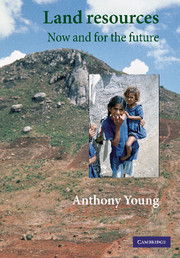Book contents
- Frontmatter
- Contents
- Preface
- Acknowledgements
- Note on acronyms and currency
- 1 Concern for land
- 2 Land resource issues
- 3 Resource survey and land evaluation
- 4 Competition for land
- 5 Working with farmers
- 6 Land use planning
- 7 Land degradation
- 8 Global issues: climatic change and biodiversity
- 9 Monitoring change: land resource indicators
- 10 Costing the earth: the economic value of land resources
- 11 Land management: caring for resources
- 12 Research and technology
- 13 Land, food, and people
- 14 Population, poverty, and conflict
- 15 Awareness, attitudes, and action
- Notes
- References
- Index
3 - Resource survey and land evaluation
Published online by Cambridge University Press: 04 August 2010
- Frontmatter
- Contents
- Preface
- Acknowledgements
- Note on acronyms and currency
- 1 Concern for land
- 2 Land resource issues
- 3 Resource survey and land evaluation
- 4 Competition for land
- 5 Working with farmers
- 6 Land use planning
- 7 Land degradation
- 8 Global issues: climatic change and biodiversity
- 9 Monitoring change: land resource indicators
- 10 Costing the earth: the economic value of land resources
- 11 Land management: caring for resources
- 12 Research and technology
- 13 Land, food, and people
- 14 Population, poverty, and conflict
- 15 Awareness, attitudes, and action
- Notes
- References
- Index
Summary
Surveys of land resources – climate, water, soils, landforms, forests, and rangelands – are needed to avoid costly mistakes and to improve efficiency of investment. Valid techniques have been developed for all types of resource survey, and the method of land evaluation has helped in translating environmental data into terms of land use potential. Soil surveys are best carried out in two stages: a reconnaissance survey on a land systems or landscape basis, followed by special-purpose surveys as required for development. Soil monitoring should become an additional basic task for soil surveys. Information on water resources, forests, and rangelands is deficient for many developing countries, and institutional capacities are weak. The extent to which surveys have been applied is far from satisfactory. Natural scientists have failed to communicate the implications of their findings, and, conversely, planners and decision-makers are not sufficiently aware of the significance of natural resource information. The proper management of land resources is so fundamental to sustainability that it should permeate the whole fabric of development, from planning through implementation to monitoring of change. The lack of communication between scientists and planners needs to be improved by more broadly based education, and strengthening of institutions.
Most of the time, farmers do not need soil surveys. From time immemorial, when taking new land into cultivation they learnt to find good soils and avoid bad, often using what would now be called indicator plants.
- Type
- Chapter
- Information
- Land ResourcesNow and for the Future, pp. 25 - 47Publisher: Cambridge University PressPrint publication year: 1998



